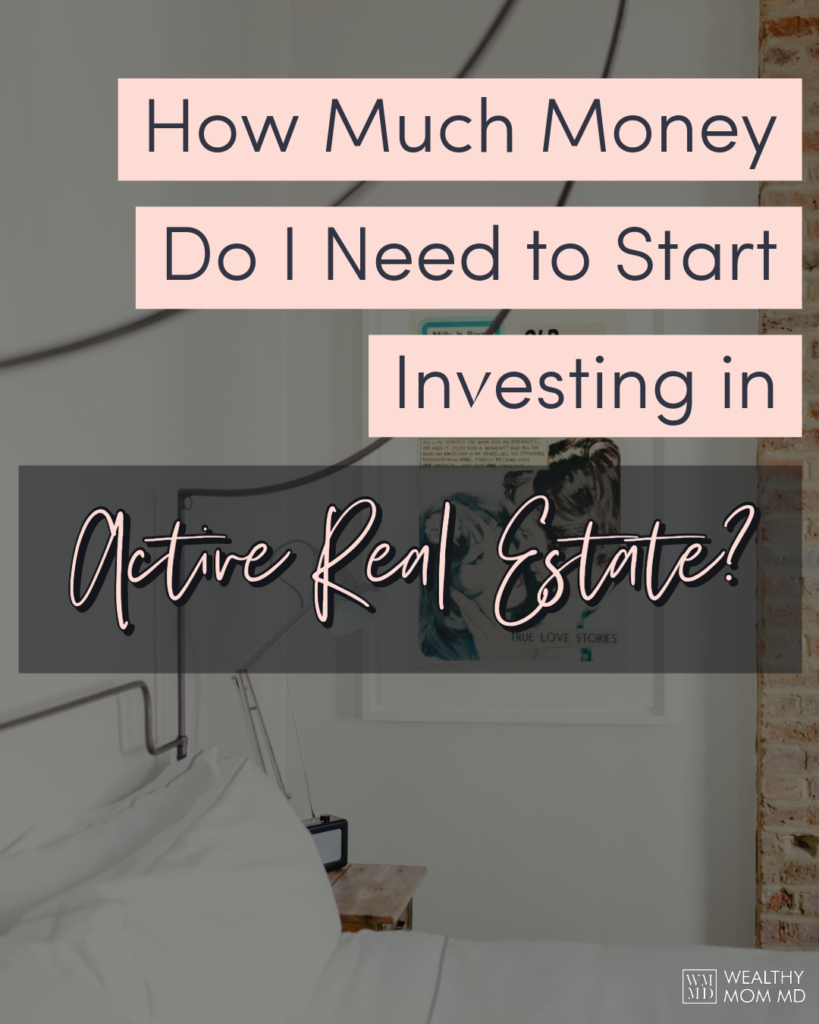Disclaimer: Please note that some of the links below are affiliate links. This means that I may receive a commission if you purchase through one of my links. I highly recommend all of the products & services because they are companies that I have found to be helpful and trustworthy. I use many of these products & services myself.
This is a guest post by Dr. Letizia Alto of Semi-Retired MD. Dr. Alto iis currently a part-time hospitalist located in Seattle, WA. She and her hospitalist husband, Kenji Asakura, MD, started investing in real estate together in early 2015 and, since then, they’ve built a sizable portfolio currently consisting of over 70 doors.
Their mission is to help other physicians achieve financial freedom through real estate while they’re still young enough to enjoy it (Fast FIRE).
Leti and Kenji teach physicians how to invest in cash flowing rentals in their introductory investment course, Zero to Freedom Through Cashflowing Rentals. The course is focused on helping doctors and other high-income professionals who have little to no real estate investment experience to get to a place where they can confidently invest in cash flowing rentals. AND it comes with CME!
In the meantime, be sure to sign up for Semi-Retired MD’s free minicourse! Note: Registration will be closed while the course cart is open.
If you’ve ever considered investing in real estate, you probably know that there are a lot of ways to make money by owning rentals.
There’s the cash flow (the money you put in your pocket after expenses), debt paydown by your renters, market appreciation, rent appreciation and forced appreciation.
You’re also using the power of leverage, so you’re making money on the bank’s money. And then you add in the tax loopholes only available to real estate investors and your returns become exponential! It’s no wonder that so many of America’s wealthiest families have made their fortunes from owning real estate.
Most people assume that you need a lot of money to make money with real estate. The truth of the matter is, you don’t need as much as you might think.
In this post, I show you the path to financial freedom through cashflowing rentals if you don’t have much money. I do this by running you through your options if you have $50,000 to invest per year, so that you get a sense of all the possibilities if you don’t have much cash on hand right now.
But before we start….
Before we jump in and discuss strategy, let’s explore your mindset.
Those of you who are regular readers of Wealthy Mom MD know that Bonnie frequently discusses how much of a role your view of money plays in whether you take control of your finances and become wealthy. Well, the same can be said of investing in real estate.
Mindset is vital to being a successful real estate investor. If you can master your fears and rid yourself of limiting beliefs then it doesn’t matter how much cash you currently have on hand to invest. You will figure out how to make it work. You will find a way to be successful.
“Success in life is 80% psychology [mindset] and only 20% mechanics [strategies]”
Tony Robbins
So, before you do anything, make sure you’ve really explored your reason for investing (your why) and have started challenging some of your own limiting beliefs (I don’t have enough time, I don’t have enough money, etc…)
Doing this alone will make all the difference in what you are able to accomplish, independent of how much money you have on hand.
With that, let’s jump into the strategy!
What if I don’t have any money?
First off, is this really true?
Now, it may be that you don’t want to tap any of the money you do have available (equity in primary home, 401K, rainy day fund) or make the changes necessary to get more money (cut back on spending, work more shifts) or make any tough sacrifices (sell your primary residence, live in an apartment building that you own) because real estate investing is not a priority for you right now.
But that is very different from saying you don’t have access to any cash.
Now, a different problem is having a negative net worth. All of us know this is an extremely common situation for physicians, especially when you’ve just graduated from medical school or residency.
I realize this is a tough situation. I’ve been there myself! If you’re staring at hundreds of thousands of dollars of owed money, it can be difficult to decide to buy property instead of aggressively paying them off. There is an emotional benefit for many of us to paying off our loans even if it slows down our path to financial freedom.
So, that being said, I know investing in real estate while you have student loans is not the right path for everyone. Ultimately you have to do what you feel comfortable with and what aligns with your “why” and goals.
But here’s why I would still buy rentals: they will help you pay off your student debt faster than just saving up to pay them off directly.
How does that work?
When we buy properties, Kenji and I buy deals that return a minimum of 10% cash-on-cash. This cashflow is tax-free. Then, when you add in the value of the equity paydown and all the types of appreciation (remember you’re making money on the banks money too using leverage!). And then you add in the tax breaks you can get from getting real estate professional tax status and the compounding you get when you reinvest the earnings of your properties into more properties…. Your returns add up quickly.
When we’ve modeled the analysis using our minimum threshold returns, we show returns of greater than 25% return per year. Our personal portfolio actual returns have far exceed even that.
This is in contrast to just taking your post-tax dollars and putting them into paying off your loans (and saving a little in paid interest) directly.
The fact is: you will get to financial freedom much faster if you invest in cashflowing rentals instead of paying off your student loans first.
So, now that we’ve tackled having no money and having significant student loans, let’s cover what your options are if you only have a small amount of cash saved.

I only have $50,000… What are my options?
If you only have $50,000, you actually have a number of options to start investing in the cashflowing rentals (note I’m excluding passive modes of real estate investing including syndication and debt funds in this article).
One of the best options is to Buy, Rehab, Rent, Refinance or BRRRR a property. This is an attractive model because you can do this with no money down. BRRRR stands for buy, rent, rehab, refinance and repeat. The goal of the BRRRR strategy is to get all your money out of a property quickly and re-use it for future purchases. The key with this strategy is that you must buy a property in need of rehab at a below-market price. You buy the property with your $50,000 cash. You then rehab the property and rent it out. A bank then uses the new rent to establish the value of the property, which allows you to walk away with significant equity and all your initially invested money back in your pocket. When you successfully BRRRR, you have infinite cash-on-cash return.
A second option is to do something called “house hack.” If you use this strategy, you can buy a multi-family property with very little money down using an FHA loan. With an FHA loan, you have to live in the property (and rent out the other units) to qualify for their low money down program (only 3.5%). House hacking allows you to buy a much larger property than you would otherwise be able to afford and to be able to pay minimal rent or live rent-free in your unit, saving money for a second purchase.
The third option is a standard purchase, putting down 25% down on a $200,000 multifamily property. Depending on your market, you could buy between 2-4 units with that amount.
I’ve bought myself a standard duplex, now what?
In this case, if you collected 10% cash-on-cash on your duplex deal, you’d be making $5,000 in cashflow a year plus having your renters pay down $2,500 per year on your loan. It may not seem like you’ve done much to change your situation.
But you have.
Because this is when you roll up your sleeves and get to work increasing the duplex’s worth so you can trade it up to a bigger property…soon.
How do you add value to your duplex with little to no money?
First, you can increase rents. When we look for something we call “hidden value” in investment properties, one of the most frequent things we see is under-market rents. Ideally, what you’ve bought is a $200,000 duplex that was renting for $1800 a month, but should actually be renting for $2100 a month ($300 added rent per month).
Other sources that you may be able to tap to increase the income of your property without or with minimal cost include renting out storage units, detached garages, adding pet rent, charging for reserved parking spots and adding in coin laundry. Let’s say you increase rents by $100 a month here.
The second thing you can do to increase the value of your property is to lower expenses. You can do this with no cost to yourself by billing back utilities or giving your tenants responsibility for landscaping costs. Let’s say you save $200 a month in utilities here.
Let’s say you do all that year one of owning the property. And, as a result, you’ve added $600 a month to rent – and approximately $120,000 of value to your property. While that may seem like a lot, it’s actually fairly easy to add this kind of value if you’ve bought a property right in the first place.
Now your $200,000 purchase is worth $320,000. After one year you could get an appraisal and take out money to buy a second property. Or you could sell this property and roll it into a bigger one.
But, for the sake of this model, let’s say you keep it.
It’s year two…
Now, the second year of owning the property, you put $50,000 in to rehab it.
Maybe you add an extra bedroom or unit. Maybe you lower maintenance costs and increase rent by putting in flooring instead of carpeting, adding nice grade finishes in the kitchen, repainting and fixing up the bathrooms.
What this $50,000 rehab does is result in much higher rents (you get >10% return on investment for your rehab), and it adds value to your property, like I showed you increasing income and decreasing expenses did above.
This is called forcing appreciation.
The value of multifamily properties is based on their net operating income (income minus expenses). When you increase income (by raising under-market rents or do rehab that results in higher rents for example) you, increase the value of the property by a multiplier. Although this multiplier is different in each market, for the sake of this example, we’ve chosen a very reasonable multiplier: for every $30 dollars of increased rent per month, you raise the property value by $6,000 (CAP rate of 6 for those of you who have real estate experience).
So, in this case, as a result of your rehab, you increase rents by $400 a month, resulting in $80,000 in value. Not only that, your rehab was also a tax write-off (though it resulted in a passive loss, which isn’t as useful as an active loss, as you’ll see below).
Now you decide to sell!
You sell your $200,000 purchase for $400,000 using a 1031 exchange, so you can do it in a tax-deferred way. Again, this may seem crazy, but we’ve done this exact scenario multiple times.
You now have about $250,000 to roll into your next property using (yes, I didn’t count selling costs here, but I also left out the cashflow you made while you owned the property and the equity pay down by your renters during the time you owned your property too).
What’s next?
For the sake of simplicity, let’s say you go bigger and just buy one property. $250,000 down will buy you an $830,000 property if you put 30% down (needed for many commercial loans). Let’s say you buy a 12-plex with this money. Your cashflow becomes $25,000 each year (tax-free!).
And now you claim real estate professional tax status.
What is real estate professional tax status?
Real estate professional tax status is a tax status that you can claim if you meet two criteria. First, you must do the majority of your working time on real estate. If you or your spouse doesn’t have a W2 job or you work part-time, this can be a fairly easy criteria to meet. Second, you need to spend a minimum of 750 hours on real estate investing each year (with at least 500 of those hours being spent on material participation on your own properties).
You can read more about real estate professional status here.
Now that you own 12 units, it’s likely that you (or your spouse) are going to meet criteria, especially if you are doing significant work on your property such as self-managing it, overseeing a rehab or visiting the site or managing your property managers.
So what does real estate professional tax status get you?
Now all of your paper losses on that property can become active losses on your taxes, sheltering your clinical or other W2 income. So now you can write off massive losses from bonus depreciation and rehabs, reducing or even eliminate your income taxes.
Having real estate professional tax status has saved us six-figures in taxes every single year. You can imagine what that does to your growth.
Therefore, the next year, you buy a new duplex with your tax savings alone. And now you’re that much closer to financial freedom.
Can you see how even a small amount of money invested in real estate can get you to financial freedom?
Real estate investing can seem overwhelming to people. They don’t know where to start.
But, as you’ve now seen, a fortune can start with just one small purchase. The key is buying the right property at the right price and knowing how to harvest hidden value and force appreciation. And then achieve real estate professional tax status quickly.
So how can you make sure you get the right property, a property that will get you that much closer to financial freedom?
You must become an educated investor. That involves not only gaining knowledge, but also finding yourself a mentor to help you avoid mistakes and a community of like-minded investors who will hold you to a higher standard.
When you have these three ingredients, there’s no limit to what you can accomplish.
Ready to start? Check out Semi-Retired MD’s FREE introductory video course.

Get the bestselling book - Defining Wealth for Women.



